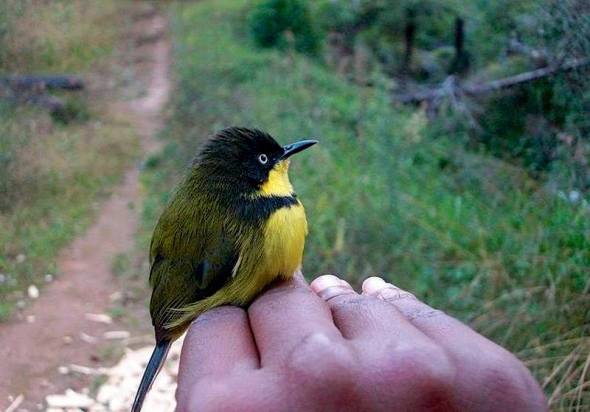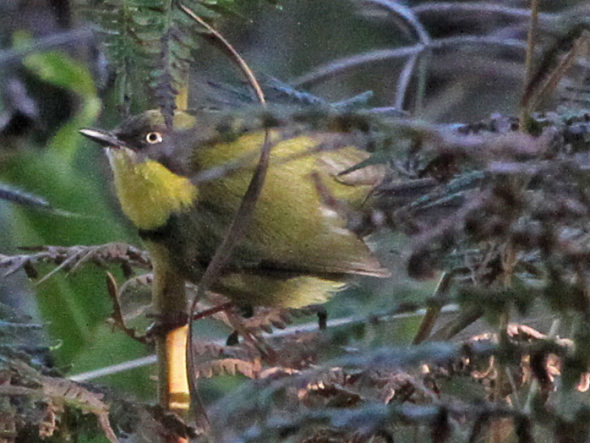Endangered Species Monday: Apalis flavigularis
Endangered Species Monday: Apalis flavigularis
This Monday’s endangered species article I focus again (with a very frustrated mind) on yet another threatened species of bird which is, one of my favorites. Scientifically named as the Apalis flavigularis the species is listed as endangered. Commonly identified as the Yellow-throated Apalis the bird was primarily discovered back in 1893 by Captain George Ernest Shelley (15 May 1840 – 29 November 1910). Captain George Ernest Shelley was an English geologist and ornithologist. He was a nephew of the poet Percy Bysshe Shelley.
Captain Shelley was educated at the Lycée de Versailles and served a few years in the Grenadier Guards.
His books included A Monograph of the Cinnyridae, or Family of Sun Birds, A Handbook to the Birds of Egypt (1872) and The Birds of Africa (5 volumes, 1896 - 1912).
Endemic to Malawi a landlocked country in southeastern Africa, is defined by its topography of highlands split by the Great Rift Valley and enormous Lake Malawi. Bordering Mozambique, Zimbabwe and, Zambia. Populations are decreasing quite rampantly throughout the birds range.
A. flavigularis is restricted within its range to the following mountainous regions Mt Mulanje, Mt Zomba, Mt Malosa in south east Malawi. From 1983 the species was once considered common within its habitat however has since declined to depressing levels. Some reports have stated that the species may-have occurred within the Mozambican region of Mount Chiperone however, there are no records to back these claims up.
Further reports suggest that the species does not occur within similar regions of Malawi or adjacent to Mozambique. Back in 2008 surveys suggested there was a mere 7,900 individuals in the cedar forest on Mt Mulanje suggesting that the species population on Mulanje may have likely exceeded to some 10,000 individuals.
In all the total population count to-date stands now at some 2,300-4,400 individuals. The species is banded within the number of 2,500-9,999 individuals. This equates to 1,667-6,666 mature individuals, rounded here to 1,500-7,000 mature individuals.
Threats
The rapidly increasing human population in south-eastern Malawi, swelled by huge numbers of refugees during the last 20 years, is posing a serious threat to the survival of mid-altitude forest in the lowest parts of its range - the lower slopes of Mt Mulanje, in particular, are steadily being deforested for agriculture and timber. In 1995-1996, severe fires destroyed some indigenous forest on Mt Zomba.
Fires cause a proliferation of invasive plants, in particular Rubus ellipticus, on Mt Mulanje, however presence of the species was found to be positively correlated with R. ellipticus by Mzumara et al. (2011) so this may not present a significant threat. The “then” Malawian president Bingu wa Mutharika granted a Japanese minerals company a concession covering the whole of Mount Mulanje to mine rare earths in 2011, and it was reported that Tuchila plateau had been clear-felled and exploratory drilling had begun in late 2011.
It is uncertain whether the subsequent change in head of state following the death of the president in April 2012 will affect the mining concession.
The new head of state President Peter Mutharika seems to have made some small changes regarding mining however nothing really major to show improvements to the natural wildlife or countries only endemic bird. Back in June 2015 the Malawian Congress Party - Law maker for Kasunga East, Madaliso Kazombo criticized mining contracts in the country for lacking transparency saying its high time locals had shares in the in the companies of foreign investors. Read more >here<
During past and to date debates the countries mining operations continue to threaten wildlife and waterholes that much of the countries large taxa depend on. Back in 2014 a uranium mine sludge discharged placed countless species of animals in danger of immediate death - not forgetting the countries most endangered bird - Apalis flavigularis.
Toxic substances flowed from the tailings pond at the Kayelekera Uranium Mine into Lake Malawi 50 kilometers (30 miles) downstream include waste uranium rock, acids, arsenic and other chemicals used in processing the uranium ore. Lake Malawi in eastern Africa is the world’s ninth largest lake, some 580 kilometers (360 miles) long, and 75 kilometers (47 miles) wide at its widest point. It extends into Malawi’s neighbors Tanzania and Mozambique.
The lake provides water for drinking and domestic use to millions of Malawians and wildlife. Part of the lake is protected as a national park, and it is inhabited by more than 850 cichlid fish species found nowhere else on Earth.
Back in 2013, Paladin Africa’s Kayelekera Mine in Karonga produced 1,066 metric tonnes of U3O8, triuranium octoxide, a compound of uranium. One of the more popular forms of yellowcake, U3O8 is converted to uranium hexafluoride to make enriched uranium for use in nuclear power plants and nuclear weapons.
A statement issued by the Natural Resources Justice Network (NRJN), a coalition of 33 civil society organizations active in the extractive industry sector – mining, oil and gas, expressed grave concerns about a recommendation by the National Water Development and Management Technical Committee in the Ministry of Agriculture that the minister issue a discharge permit to Paladin Africa.
Conservation actions under way include: All remaining indigenous forest within the species’s range is legally protected within Forest Reserves, but this no longer confers much protection.
Conservation actions proposed: Examine its taxonomic status in more detail. Initiate a campaign in Malawi to promote public awareness and support for forest conservation. Strengthen protection of remaining forest habitat. Conduct surveys to assess its population size and distribution. Establish a programme to monitor its population and habitat on a regular basis.
Thank you for taking to the time to read and, please share.
Dr Jose C. Depre.
Environmental and Botanical Scientist.




